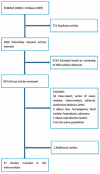Oral Contraceptives Use and Liver Cancer Risk: A Dose-Response Meta-Analysis of Observational Studies
- PMID: 26512555
- PMCID: PMC4985369
- DOI: 10.1097/MD.0000000000001619
Oral Contraceptives Use and Liver Cancer Risk: A Dose-Response Meta-Analysis of Observational Studies
Abstract
Studies about the association between oral contraceptives use and liver cancer risk have generated controversial results. Therefore, a meta-analysis of cohort and case-control studies was performed to quantitatively summarize the existing evidence.Eligible studies were identified by a computer search of PubMed and Embase databases and handed-search of reference lists, without any limitations. Study-specific risk estimates (RRs) with 95% confidence intervals (CIs) were combined with random-effects model.A total of 17 articles were included in this meta-analysis. Overall, there was no statistically significant association between oral contraceptives use and liver cancer risk (RR: 1.23, 95% CI: 0.93-1.63). In a dose-analysis of meta-analysis, a linear relationship between oral contraceptives use and liver cancer risk (P for linearity = 0.391) was found, although this correlation was not statistically significant.Oral contraceptives use was not positively associated with the risk of liver cancer.
Conflict of interest statement
The authors have no conflicts of interest to disclose.
Figures






References
-
- Yang Y, Zhang D, Feng N, et al. Increased intake of vegetables, but not fruit, reduces risk for hepatocellular carcinoma: a meta-analysis. Gastroenterology 2014; 147:1031–1042. - PubMed
Publication types
MeSH terms
Substances
LinkOut - more resources
Full Text Sources
Medical

